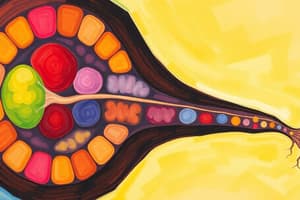Podcast
Questions and Answers
What is the term for a newly fertilized ovum?
What is the term for a newly fertilized ovum?
- Blastocyst
- Zygote (correct)
- Placenta
- Embryo
What is the size of a zygote at the point of fertilization?
What is the size of a zygote at the point of fertilization?
- Similar to a small marble
- Approximately 1 inch long
- About the size of a grape
- The size of the period at the end of a sentence (correct)
What structure develops after implantation to nourish the embryo?
What structure develops after implantation to nourish the embryo?
- Umbilical cord
- Placenta (correct)
- Zygote
- Fetus
At what stage of development is a fetus just over one inch long?
At what stage of development is a fetus just over one inch long?
What is the term for the newly fertilized ovum?
What is the term for the newly fertilized ovum?
At 8 weeks, how long is the embryo approximately?
At 8 weeks, how long is the embryo approximately?
When does the placenta begin to form in the development process?
When does the placenta begin to form in the development process?
What process occurs when the blastocyst embeds itself in the inner uterine wall?
What process occurs when the blastocyst embeds itself in the inner uterine wall?
What connects the fetus to the placenta?
What connects the fetus to the placenta?
During which period did cell division in the embryo double approximately every 24 hours?
During which period did cell division in the embryo double approximately every 24 hours?
How long is a newborn infant after 9 months of development?
How long is a newborn infant after 9 months of development?
What develops in the embryo by 8 weeks of gestation?
What develops in the embryo by 8 weeks of gestation?
What is the correct sequence of embryonic development stages following fertilization?
What is the correct sequence of embryonic development stages following fertilization?
During which stage does the fetus continue to grow and develop its organs?
During which stage does the fetus continue to grow and develop its organs?
How much heavier does the infant grow from fertilization to term?
How much heavier does the infant grow from fertilization to term?
What happens to the rate of cell division in the embryo after the first eight weeks?
What happens to the rate of cell division in the embryo after the first eight weeks?
What is the primary consequence of an adverse influence during the early stages of embryonic development?
What is the primary consequence of an adverse influence during the early stages of embryonic development?
Which of the following neural tube defects is characterized by the absence of brain tissue?
Which of the following neural tube defects is characterized by the absence of brain tissue?
How many pregnancies in the United States are typically affected by neural tube defects each year?
How many pregnancies in the United States are typically affected by neural tube defects each year?
What is the hallmark of spina bifida?
What is the hallmark of spina bifida?
When does the critical period for neural tube closure occur during gestation?
When does the critical period for neural tube closure occur during gestation?
What typically happens to pregnancies affected by anencephaly?
What typically happens to pregnancies affected by anencephaly?
What tissues or organs are specifically mentioned as being impaired by early adverse influences during development?
What tissues or organs are specifically mentioned as being impaired by early adverse influences during development?
Which of the following is NOT classified as a neural tube defect?
Which of the following is NOT classified as a neural tube defect?
What is the recommended amount of fruits for pregnant and lactating women?
What is the recommended amount of fruits for pregnant and lactating women?
How much protein foods should pregnant and lactating women consume daily?
How much protein foods should pregnant and lactating women consume daily?
What is included in a sample breakfast for pregnant and lactating women?
What is included in a sample breakfast for pregnant and lactating women?
Which vegetable is part of the sample dinner provided?
Which vegetable is part of the sample dinner provided?
What is the range of recommended vegetable intake for pregnant and lactating women?
What is the range of recommended vegetable intake for pregnant and lactating women?
What is a recommended drink for a midmorning snack?
What is a recommended drink for a midmorning snack?
Which food group has a recommended amount of 6–8 oz for pregnant and lactating women?
Which food group has a recommended amount of 6–8 oz for pregnant and lactating women?
What dairy product is included in the sample menu for lunch?
What dairy product is included in the sample menu for lunch?
What sources are recommended for obtaining sufficient folate?
What sources are recommended for obtaining sufficient folate?
Why do pregnant women have an increased need for vitamin B12?
Why do pregnant women have an increased need for vitamin B12?
What is the primary concern for vegans regarding vitamin B12?
What is the primary concern for vegans regarding vitamin B12?
What function does iron serve for pregnant women?
What function does iron serve for pregnant women?
What can happen if a woman enters pregnancy with inadequate iron stores?
What can happen if a woman enters pregnancy with inadequate iron stores?
How does the placenta regulate iron transfer to the fetus?
How does the placenta regulate iron transfer to the fetus?
What complicates iron levels in women after childbirth?
What complicates iron levels in women after childbirth?
What dietary elements are suggested to help meet a pregnant woman's nutritional needs?
What dietary elements are suggested to help meet a pregnant woman's nutritional needs?
Flashcards are hidden until you start studying
Study Notes
Stages of Development
- Zygote Formation: A fertilized ovum forms a zygote, roughly the size of a period. Rapid cell division occurs within the first week.
- Blastocyst and Implantation: The zygote evolves into a blastocyst, which floats to the uterus for implantation.
- Embryonic Growth: By 5 weeks, the embryo is about ½ inch long, forming a placenta for nourishment.
- Fetal Development After 11 Weeks: The fetus measures over 1 inch long, featuring an umbilical cord and blood vessels linking it to the placenta.
- Newborn Size: After 9 months, a newborn infant is approximately 20 inches long, having grown 20 times in length and 50 times in weight since 8 weeks.
Neural Tube Defects
- Prevalence: About 3,000 pregnancies in the U.S. are affected by neural tube defects annually.
- Types of Defects: Common defects are anencephaly (absence of brain) and spina bifida (incomplete spinal cord closure).
- Anencephaly: Occurs when the neural tube doesn’t close at the upper end, leading to severe outcomes; typically results in miscarriage or early infant death.
- Spina Bifida: Involves incomplete closure around the spinal cord, resulting in various complications.
Nutritional Needs During Pregnancy
- Dietary Recommendations:
- Fruits: 2 cups
- Vegetables: 2½–3 cups
- Grains: 6–8 ounces
- Protein Foods: 5½–6½ ounces
- Milk: 3 cups
- Folate Importance: Essential for fetal development; should come from supplements, fortified foods, and a balanced diet rich in fruits and vegetables.
- Vitamin B12: Pregnant women require more B12 to activate folate enzymes; vegans need to supplement due to dietary restrictions.
- Iron Requirements: Increased blood volume and fetal needs elevate iron needs; sufficient maternal iron stores are critical, as the fetus draws from them.
- Placental Iron Transfer: The placenta prioritizes fetal iron needs, impacting maternal health and potentially leading to deficiencies postpartum.
Studying That Suits You
Use AI to generate personalized quizzes and flashcards to suit your learning preferences.




